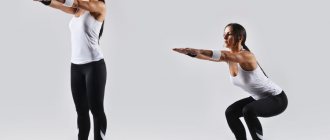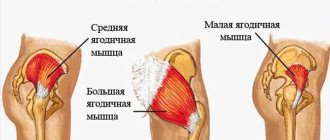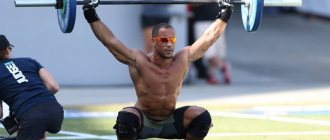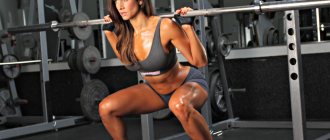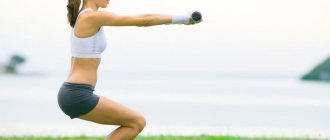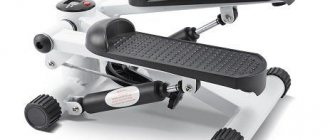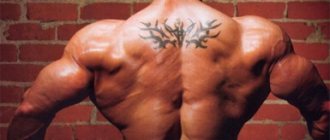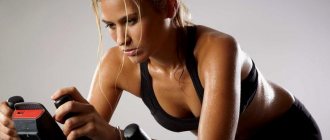Which squats and in what quantity are most effective for the gluteal muscles?
It’s no secret that the beautiful shape of a woman’s butt affects both guys and older men no worse than the red banner of a bullfighter affects a bull. And absolutely regardless of whether these nut-shaped and toned buttocks are covered in denim shorts from a sale or a dress from Armani. This is how nature decreed it - whether someone likes it or not. Obviously, working on this part of the body is very important for girls and women. But not all of them are ready to immediately sign up for a gym and gruelingly work with a barbell. Is it possible to get by with cheaper and simpler means? It turns out that it is possible! And the main one of these means is called “squats”. But how much do you need to squat to pump up your buttocks? How often and with what load should I do this? Use one or more variations of this exercise? And is it necessary to combine this with proper nutrition? Let's start answering the questions posed in order.
Why squats?
There are several reasons for choosing squats. Firstly, they do not require any special premises or any preliminary physical training. Secondly, their effect on the body is universal and multifunctional. Simple squats can not only make your buttocks firm and strengthen your thigh muscles (as a type of strength exercise), but also have a beneficial effect on the body as a whole (as one of the simplest types of aerobic exercise). Finally, thirdly, this exercise helps you lose weight - without leaving your home.
Why does this happen?
at the moment of squatting, the back, abs, gluteal and thigh muscles experience a tensile load;- when straightening your legs, dynamic pressure is added to them, since your body itself plays the role of a load;
- muscle load causes increased blood circulation, positively affecting blood vessels;
- tissues begin to be more actively supplied with oxygen, and after a certain time they begin to be freed from lipids.
It is impossible to answer the question of how quickly fat is burned. The rate of destruction of its deposits depends on the duration, speed, number of approaches, the presence or absence of additional weights and some other factors. But as an example, we can give the following calculation: with a body weight of 60 kg, squats at an average pace (1 squat per 3 seconds) will burn about 250 kcal in 30 minutes. Of course, you won’t be able to squat without a break for that long. But if you do 6 approaches a day, 5 minutes each, you will get the same result.
It should be remembered that squats are not always possible.
This exercise should not be done in the following cases:
- for injured hips, knees or ankles;
- during the rehabilitation period after recent fractures;
- with inflammation or severe muscle strains;
- for other diseases accompanied by high fever.
With caution and only after consulting a doctor:
- pregnant women;
- overweight people (body weight index 30 units or more);
- with high fragility of bones and joints.
What do experts recommend remembering first?
- You should start squats after a short warm-up. In our case, it includes a slight rotation of first the ankle, then the foot of one leg, and then the other. It is necessary to make at least 8–10 rotational movements.
- In most squat methods, you need to rest on your entire foot, without lifting up on your toes.
- The back should always remain straight.
- While doing squats, keep your abdominal muscles tense. Thus, in parallel with training the gluteal muscles, you will achieve a small loss of fat from the abdomen, and also strengthen the muscle corset in the back and lower back.
- Don't try to do too many squats per unit of time. Medium pace is not only safer, but also more effective.
- Breathe evenly, lowering with a slow inhale and rising with a full exhale.
Smith machine squats
These squats are different in that the problem with stabilizing movements is COMPLETELY eliminated. You move along a strict trajectory dictated to you by the simulator.
This allows you to move your feet much further forward to shift the load on your gluteal muscles.
Nothing special about technology. As with most regular squats, only before starting the movement you will need to rotate the bar slightly around its axis to remove it from the hooks and begin the movement.
Before finishing the approach, you need to do the same thing, only in the opposite direction (to put the bar in place).
You can do a wide variety of exercises at Smith.
The most concentrated and one of the best exercises for the gluteal muscles is the following exercise.
Let's diversify squat techniques
Not everyone knows that there are more than two dozen different squat techniques. Some of them are quite exotic, some are too difficult for beginners. For this reason, we will provide a list of only the most popular options, which are also aimed at achieving our main goal - the formation of an elastic and beautiful butt.
- Classic. Starting position – feet shoulder-width apart, toes slightly turned to the sides. During squats, the back remains straight, the gaze is directed strictly forward, the heels do not come off the floor. Load – buttocks, front and back of the thighs.
- Plie. A method that has gained worldwide fame thanks to ballet (the prima dancers of the Bolshoi Theater do at least 1000 such squats a day). Starting position – legs wide apart, toes outward at an angle as close as possible to 180°. Load – external gluteal muscles, inner thighs and pelvic muscles.
- Front squat. Starting position – feet shoulder-width apart, arms raised up, back absolutely flat and straight, feet firmly on the floor. Squats are done so that even at the lowest point of the amplitude, the knees are not further than the toes. Load – buttocks (maximum).
- Hindu. An extremely beautiful and original type of squats, included in the mandatory set of exercises for oriental dancers. Starting position – legs together, arms spread slightly to the sides. Squats are performed with wave-like movements of the hips and arms. Load – working out the buttocks and thighs. Note: Men go crazy when they see moves like this!
- Wall Squats. They are performed in the same way as classic ones, but without lifting the back of the head, shoulders, back and buttocks from the plane of support. At the lowest point (when the thighs become parallel to the floor), we fix the position for 2-3 seconds. The main task of this type of squats is to learn to maintain correct posture.
- Squats with weights. Only for experienced people who do not have problems with excess weight. Increase the weight gradually - starting from dumbbells of 1.5 kg each and ending with a barbell with which you will be able to squat without harming your joints. Note: For the formation of elastic, toned and beautiful buttocks, this exercise is most effective.
A very good help in your training would be to watch several visual videos where squats are performed by an experienced fitness instructor.
Powerlifting barbell squats (sumo squats)
They are not much different from regular squats, but they are the BEST EXERCISE for increasing the mass of the gluteal muscles (for girls, this is generally the best exercise, in principle).
In another way, this type of squats is called: sumo squats.
Indeed, if you look from the outside, the body position is very similar to how sumo wrestlers begin their fights, the only difference being that during such squats our hands are not on our hips, but on the bar.
This is an excellent type of squat that minimizes the risk to the knee joints (since the legs are placed wider, and part of the load is shifted to the buttocks, and to another large muscle group - the back).
Because As the load is partially shifted to your back, the requirements for stability of your back, and in particular your lower back, increase. Be sure to add hyperextension (as if you are pumping your abs in reverse) to your workouts to strengthen your lumbar region.
Sumo squat technique
- We approach the squat rack (as a rule, there are limiters there, install them, they give additional confidence).
- We grab the bar with a fairly narrow grip (thumbs slightly wider than shoulders).
- We place the bar ON YOUR BACK, usually 80-120 millimeters lower than with regular squats.
- Strain and straighten your back, remove the bar from the racks. Attention: While performing squats, your feet must be pressed to the floor ENTIRELY!!! There should be no calf raises!!!
- We keep our heads either straight or look up. This will allow us to keep our back straight at every point of the amplitude!
- We place our feet 100-150 millimeters wider than our shoulders. The toes point outward at 45 degrees (i.e., figuratively, our feet should form a right angle).
- The back is straight, the head looks straight or up, we begin to bend the legs.
- We move the pelvis down and BACK, while simultaneously bending the legs at the knees (the knees do not go beyond the toes). We tilt the body slightly forward.
- We squat either until our thighs are parallel to the floor, or slightly lower.
- The body at the lowest point is tilted approximately 45 degrees, the back is PERFECTLY FLIGHT, the pelvis is laid back.
- THE LOAD SHOULD RESIST ON THE HEELS OF THE FEET, not on the toes.
- WE FEEL THE CONTRACTION AND TENSION OF OUR QUADRICEPS, we begin to move upward.
- We strain our quadriceps, straight back, look up or straight, stand up, constantly thinking about how the quadriceps feel. You must feel them AT EVERY POINT OF AMPLITUDE, otherwise, otherwise, the load may not hit the target exactly, but will “spread” over the back, buttocks and other muscles.
For those who are asking how to quickly pump up your buttocks by doing just one exercise, here is your answer - DO SUMO STYLE SQUATS.
About the number of daily squats
Finally, we move on to the main question of our topic - how many squats per day should you do to properly pump up your buttocks?
Their number should be increased gradually.
- Week 1 – 6 sets of 5 squats each (30 in total).
- Week 2 – 5 sets of 10 squats each (50 in total).
- 3–4 weeks – 5 sets of 15 squats each (75 in total).
- 1–3 months – 4 sets of 30 squats of different types (120 in total).
- 3–6 months – 4 sets of 35 squats of different types, including with weights (140 in total).
- 1 year – 4 sets of 40 squats of different types with more massive weights (160 in total).
With such training experience, it would be optimal to add other types of exercises to squats. We recommend reading the article “What exercises will help build up your gluteal muscles?”
How many squats per day is recommended?
It is not easy to answer this question, since the specific number of squats depends on a number of factors: the physical condition of the student, age, his weight and the goal that he has set for himself.
If we talk about beginner athletes, then they should start with high-repetition squats without weight. However, first you need to master the correct technique for performing them. In the first week of training, it is recommended to perform 4-5 series of 10 squats. Thus, a novice athlete will perform 40-50 squats a day, and training should be done every other day so that the leg muscles have time to rest and recover.
Subsequently, you can either increase the number of squats or start using additional weights. You will soon notice that the muscles in your legs have become stronger, and your legs themselves look more beautiful and toned.
How to squat correctly to pump up your legs
This article will present the most effective exercises to pump up your legs with squats. You will learn how to squat correctly with and without a barbell, dumbbells (weights). Every self-respecting bodybuilder should be able to squat correctly
Squats
Muscles: Glutes, hamstrings, quads, calves, abs.
- Starting position: feet shoulder-width apart. Place the barbell on your shoulders if your form allows, or pick up dumbbells.
- Bend your knees and hips at the same time, lowering yourself down. Stop when your thighs are parallel to the floor, but you can go lower if you feel no difficulty.
- Straighten your knees and return to the starting position.
NOTE. Always keep your back straight; the projection of the knees should not extend beyond the toes.
Step up with and without dumbbells
Get ready to step up to the heights of bodybuilding with toned legs.
Muscles: Gluteal, hamstrings, quadriceps, shoulders, abs.
- Starting position: feet shoulder-width apart, facing a bench or platform approximately 30-90 cm high. If you feel sufficiently prepared, take dumbbells in your hands and press them to your sides.
- Step up, lifting your right knee, and place your foot on the bench. Straighten your right leg and push your whole body up.
- Return to the starting position and repeat the movement with your left leg. So you took the first steps towards legs that look decent in the shortest shorts.
Barbell Lunge
Lunging like crazy is perhaps the healthiest way to get insanely muscular legs.
Muscles: Glutes, hamstrings, quads, calves, abs.
- Starting position: feet hip-width apart. Place the barbell on your shoulders if you are prepared enough, or pick up dumbbells.
- Take a giant John Cleese-style step forward with your right foot. The right thigh should be parallel to the floor.
- Return to the starting position. Be careful not to fall when you start to get tired; it will happen very soon. Balance on one leg is not easy. Repeat the same with your left leg; soon your legs will be strong enough to hike to the Sahara and back.
Barbell Lunge Squat
Pumped up arms are inexpensive if not balanced by a pair of equally toned up legs.
Muscles: Quadriceps, glutes, hamstrings, abs.
- Lunge with your right foot forward. Place the barbell on your shoulders if you are prepared enough, or pick up dumbbells.
- Bend both knees so that the back one just barely touches the floor. Return to the starting position.
- Change the position of your legs and repeat. Starting your car using a pushrod will soon no longer be a problem for you.
Leg press
Build the teardrop muscles above your knees that make your bike go faster.
Muscles: Quadriceps, glutes, hamstrings, calves.
- Climb into the leg press machine and take on the machine so John Connor can make an example of you. Press your buttocks and back against the backrest, rest your feet hip-width apart on the platform above.
- Press the weight up, straightening your legs. Don't overextend your knees.
- Release the support and slowly lower the weight until your legs are bent at a 90° angle. Straighten your legs again, but don't overextend them.
Leg extension on the simulator
It's time for another man versus machine battle. After winning this battle, you will have enough strength to kick the ball into the opponent's goal across the entire field.
- Sit on the leg extension machine, placing your buttocks flat on the seat. Hook your feet onto the roller.
- Slowly extend your legs up and forward until fully extended, but do not overextend your knees.
- Pause, then slowly bend your knees and lower your legs.
Squat Lunge with Jump
This leg strength exercise, when done correctly, can make your scrotum jump out of your workout shorts. Be especially careful if you prefer to exercise in jogging shorts.
Muscles: Quadriceps, glutes, hamstrings, calves, core.
- Stand in a lunge position, right leg in front, left leg behind, knees slightly bent. If you want, take small dumbbells or weights in your hands and press them to your sides.
- Bend your knees and jump up. Change the position of your feet in the air and land with your left foot in front.
- Bend your knees as you land to soften the impact.
NOTE. If you have problems with your knees, work only with your own weight.
Calf Raise
The hamstrings are not the muscles whose shape and size you usually show off to your friends, but they are the ones that bear the responsibility when you are passing your opponent on the sports field. So you'll probably want to tense them up in public.
Muscles: Hamstrings, gluteals.
- Lie down on the hamstring exercise machine with your body pressed against the platform. Ankles under the bolster.
- Bend your legs and pull the roller towards your buttocks.
- Lower the roller to its original position for 3-4 seconds. This exercise is very difficult to do incorrectly because the machine only works in one way.
Deadlift for legs
This leg strength exercise will keep you on your feet even when your less fit peers are hobbling around in walkers.
Muscles: Hamstrings, lower back, abs.
- The technique for performing the leg exercise is almost the same as for a traditional deadlift; the only difference is that the knees remain straight (in no case overextended) during the movement. Place the barbell in front of you and grab it with an overhand grip.
- Straighten your back and lift the barbell. Keep her as close to you as possible.
- Within 2-3 seconds, lower the bar to its original position. This will strengthen and stretch your hamstrings, which will be useful for you on the sports field, and will also help you master a couple of new positions in the bedroom.
Exercises
Classic squats
Why: training the quadriceps and thigh muscles.
How: The exercise is performed without additional weight. Everything is simple here. Keep your back straight. Clasp your hands in front of you. Squat. The shins and elbows should be in line.
Classic squats are great for beginners. This exercise will prepare you for an intense glute workout. It is not suitable for increasing muscle mass.
Deep squats
Why: load on the medius and major muscles of the thigh, quadriceps and buttocks.
How: The exercise is similar to classic squats. However, there is one difference: the pelvis should be lowered until it is parallel to the plane of the floor.
This exercise is quite difficult to perform. Ankle flexibility is key here. If this part of the body is not flexible enough, then you will not be able to squat deeply.
With a narrow stance
Why: training the medius, major and quadriceps muscles. The lumbar and abdominal muscles also work.
How to: Stand with your feet shoulder-width apart. Spread your feet slightly apart. Squat until your thighs are parallel to the floor.
If the exercise seems too difficult, place your feet a little wider or turn your toes out slightly. This way you can keep your body balanced and properly load your muscles.
Sumo squats
Why: load on the large, middle and quadriceps muscles.
How to: Stand straight and spread your legs out to the sides. Turn your feet outward. Inhale and slowly squat down, keeping your back straight. At the end point, your thighs should be parallel to the floor. An important point is that the knees are in the same plane as the toes and do not connect. Move your pelvis back as far as possible. Exhale and slowly return to the starting position.
Exercise "Curtsy"
Why: training the large, medius buttock and quadriceps muscles. Additional load on the hamstrings.
How to: Stand up straight, place your feet wider than shoulder-width apart, and point your toes out to the sides. During the exercise, point your knees in the same direction as your toes. Shift your weight to one leg and take a long diagonal step back with the other. One leg is in front and the toe of the foot is pointed outward. The other is behind the first. Legs crossed.
Sit down. The knee of the front leg should be parallel to the floor. With the knee of your supporting leg, reach towards the floor behind your working leg, but do not touch it. At the bottom of the squat, you should feel a stretch in the gluteal muscles of your working leg. Straighten your legs and lift your pelvis.
Squats with dumbbells
Why: load on the thighs, abdominal muscles and triceps.
How: The technique for performing the exercise is the same as for classic squats. Similar muscle groups are involved.
Training with dumbbells loads the gluteal muscles and allows you to achieve the desired results faster.
Squats
Why: training the buttocks, thigh and back muscles.
How: The technique is the same as for dumbbell squats.
The most effective training option, however, this exercise is contraindicated for people with spinal pain.
Exercise "Plie"
Why: training the femoral, gluteus medius and maximus muscles.
How to: Grab a kettlebell. Stand up straight, place your feet wider than shoulder-width apart and point your toes apart. Squat down slowly, holding the weight between your legs. At the end point, the thighs should be parallel to the floor. Return to the starting position.
Perform squats by working your buttocks, not your thigh muscles. To do this, you will have to consistently control your movements.
Deep squats on one leg
Why: load on the gluteal muscles.
How to: Stand against a wall and place your hand on it. Raise one leg and keep it parallel to the floor. Squat.
This exercise requires physical preparation.
How to pump up your legs and improve your health with squats at home
Squats have a huge healing and general strengthening effect on the entire body and this movement is extremely useful at any age! This exercise also strengthens the muscles of the legs and buttocks, and indirectly tenses (as stabilizers) the core muscles, including the abdominals.
The fat burning effect of this exercise is extremely high compared to other exercises. Unfortunately, this effect will only appear if you eat properly, at least with a slight calorie deficit in the diet.
Suppose you have weak or thin legs, and you want to properly strengthen them at home. I won’t ask: “Why not just join a gym?” Everyone has their own reasons for working out at home: some want to save on a gym membership, while others don’t have a gym nearby. Today we will do everything possible to build strong and resilient leg muscles at home, and believe me, success is guaranteed!
Bodyweight squats
So, the first stage that you will need to go through is to master the squat technique and prepare the muscles for serious work. Start doing squats with a minimum number of repetitions, we have nothing to be ashamed of and there is no rush!
If you have not been involved in sports, or are not sure about the health of your knee joints, squat shallowly at first, or holding onto the back of a chair. Perform bodyweight squats every other day, do three sets, gradually increase the number of times and depth of the squats.
You must learn to squat smoothly, without jerking, resting on your heels, but in no case on your toes! To do this, when doing squats, you need to move your hip joint back.
Bodyweight squat technique
1. Place your feet wider than shoulder width
2. Turn your toes to the sides 45 degrees
3. When performing squats, start the movement by spreading your knees to the sides
4. After inhaling, move your pelvis back and squat on the heels of your feet.
5. To avoid losing your balance and falling backward, simultaneously lean your body forward and extend your arms forward in front of you.
6. After exhaling, return to the starting position, resting primarily on the floor with your heels. This does not mean that socks should come off the floor! Below I have attached a video of the technique that you need to watch.
You can do a small number of repetitions at first until your muscles become accustomed and adapt to the load. Then start increasing the number of movements. For example, in the first workout, do 3 sets of 6 repetitions, in the second 4 sets of 8 repetitions, in the third 5 of 10, in the fourth 5 of 12. When you can complete 5 sets of 15-25 repetitions, with a break of 1-2 minutes, it is no longer practical to work with your own weight! Further progress will be slowed down, so you need to complete the following step:
Squats with weights
Don't be afraid to use extra weight! We can start with light weights, say 1 kg dumbbells. At the moment I am training several students via Skype who are over 60 years old, and they are successfully squatting with dumbbells of 5, 10 kg, and even more! This greatly improved the muscle tone of these people, they became more mobile, healthier and rejuvenated.
They can easily walk 10,000 steps daily and their bodies have become toned and in good shape. Overall, after 1 year of doing squats and other exercises at home, they began to feel at least 10 years younger (in terms of physical fitness). Agree that the benefits of exercise are obvious!
Squat technique with additional weight
Do the exercises every other day. But, if you start increasing the weight of the weights, change the load every workout! On Monday, work with maximum weight (5 sets of 10-15 repetitions), Wednesday, work lightly (3 sets of 12 squats without weight), Friday, use small dumbbells (3 sets of 10 repetitions, avoiding extreme fatigue).
Also, over time, you need to add other exercises for home, so I am attaching a training program for men and girls, for home, see the links!
Don't forget to watch the video, technique is very important:
Squat complex
Exercises should be performed daily, repeating each exercise 15-20 times. Then, when it is no longer difficult to do such a complex, increase the load or add additional weight.
Exercises without weight
A regular squat will help strengthen your buttocks and improve the overall condition of your leg muscles. Carry out it, keeping in mind all the rules and nuances listed above. Stand straight with your feet slightly wider than shoulder-width apart. As you inhale, do a squat, and as you exhale, straighten your knees.
Plie will pump up the gluteal muscle, external and internal thigh muscles. To perform this exercise, stand straight with your feet slightly wider than shoulder-width apart. The feet are turned to the sides. Inhale and lower yourself down; as you exhale, return to the starting position. Try not to stick out your buttocks.
Combine squats with body wraps and anti-cellulite massage.
If the gluteus maximus muscle needs to be worked, do the movement with a narrow foot stance. Bring your legs together and do a normal squat. The exercise may seem difficult at first, but over time it will not be difficult to perform.
The Curtsy exercise tones the gluteal muscles. Cross your legs. As you inhale, move your pelvis back, bending your legs to a right angle at the knees. Shift your weight to your front foot. The second leg does not touch the floor with the heel. As you exhale, return to the starting position.
The “Balance” movement will give increased load on the buttocks. Place your feet hip-width apart. Lift the heel of your right foot up. As you inhale, do a squat, transferring your weight to your left foot. Return to the starting position and repeat, switching legs.
“Swallow” is an advanced exercise that will significantly increase the load on the buttocks, back of the thighs, and back muscles. Holding the chair with your hands, stand on one leg. The second is laid forward and bent at the knee. Try to keep it suspended. Perform a squat while inhaling, moving your body forward and your free leg back. As you exhale, return to the starting position.
Squats with additional load
At home, it is better to take dumbbells as an additional load. This weight will not put additional stress on the spine, but will help increase the effectiveness of the exercise.
Place your feet shoulder-width apart (or slightly narrower, at pelvic level). Take dumbbells of a suitable weight in your hands. Start with light weights and gradually increase it. Perform a normal squat, trying to get your hips as low as possible. If your arms are down, lightly touch the dumbbells to the floor at the bottom of the squat. Do not lift your heels, otherwise the load will be distributed incorrectly.
The weight of the barbell will be selected by the instructor at the fitness club.
Squats with a barbell should only be done with good physical fitness and under the supervision of an instructor. This is a high-impact exercise that will help you build muscle mass effectively.
Is it enough to just squat for maximum leg muscle development?
The author of the Strength & Conditioning Research resource, Chris Beardsley, decided to answer the question of many trainees - is it possible to achieve maximum development of the thigh muscles through barbell squats alone. The editors of Zozhnik decided that they should not deprive their readers of such interesting information. Let's give the floor to Chris.
From time to time on the forum people ask: “What is the best way to plan a workout to develop the muscles of the lower body?” One well-known athlete gave a short recommendation: “Just squat.” But is it really possible to achieve optimal thigh muscle development by squatting alone?
Testosterone production when doing squats
The legs are the LARGEST muscle group in our body.
Performing leg exercises requires a huge amount of effort, energy and recovery capacity.
Leg training is always a HUGE STRESS for the body. After all, almost the entire body is involved in this process.
The muscles of the legs (of course), core, back, arms, etc. become tense.
Blood circulation in the lower part of the body increases, which leads to stimulation of the sex glands (in men), which then leads to the production of a huge amount of ANABOLIC HORMONES (testosterone, primarily).
Almost always, anabolic hormones are released in excess, which is enough for the restoration and growth of other parts of the body.
Especially, this is very useful for athletes who train naturally. Indeed, it is in this case (when you train without steroids and other stimulants) that the production of your OWN testosterone plays a leading role.
We must try with all our might to create a favorable anabolic background for the body to grow.
Muscles of the back of the thigh: “Squat, but don’t forget about the deadlift?”
Fitness professionals know that squats are very effective for developing the quadriceps, adductor magnus and gluteus maximus muscles, but are not very effective for developing the hamstrings (Wright et al. 1999).
This is why a variety of deadlift variations (plus other exercises) are always included in a good training program to target the posterior chain muscles (those located on the back of the body)*.
To support the opinion that squats are incapable of properly loading the muscles of the hamstrings, we present the following data:
- Increasing the weight on the barbell in the squat does not increase hamstring activation , but does significantly increase quadriceps and gluteus maximus activation (Li et al. 2013).
- Lowering into a deeper squat with the same load does not increase hamstring activation , but does increase quadriceps and gluteus maximus activation much more (Gorsuch et al. 2013; Contreras et al. 2015b).
How deep to squat
It's not the depth that matters, but the style in which you squat. But it is a fact that a deep squat engages the gluteal muscles more strongly. In this case, the knee joints are bent as much as possible and the work of the quadriceps and muscles of the back of the thigh (hamstrings) is limited at the beginning of the lift.
When squatting below 90 degrees, the initial impulse is set only by the gluteal muscles, and only then the leg muscles are involved.
There are such concepts as the concentric phase of movement (when we lift the weight) and the eccentric phase (when we lower the weight). Research shows that heavy eccentric phases break down muscle more than heavy concentric phases. During a full squat, the glute goes through a greater range of motion (maximum lengthening and greater damage), which subsequently is a growth factor.
Why do the muscles of the back surface weakly engage during squats?
If we consider this issue from a biomechanical point of view, then, most likely, weak activation of the posterior muscles during squats is due to the fact that these muscles are bi-articular. They work as both hip extensors and calf flexors.
So, when you lower yourself into a squat (flexing your hip and shin), the muscle contracts closer to the knee but stretches closer to the hip joint. Roughly speaking, its length remains almost unchanged. When you rise from a squat (extending your hip and lower leg), the opposite happens - the muscle stretches closer to the knee, but contracts near the hip joint. Again, its length remains almost unchanged. This makes the hamstrings less effective as hip extensors during squats.
You might say, “I don’t care what the research says about lack of activation, I can feel my hamstrings firing when I squat.” And, of course, I will not argue with this.
You should really feel the muscles in the back of your thigh working during squats - that's where the adductor magnus is located. This is a very large muscle that is an important hip extensor during squats. It is located next to the muscles of the back surface, so in most cases you feel its work.
Squats and quadriceps femoris
The quadriceps consists of 4 muscles located on the front of the thigh. By the way, just recently scientists discovered a new muscle, which they called the “tensor vastus intermedius” (Grob et al. 2016).
While researchers work through updating anatomical nomenclature, we will recall the names of the four main muscles of the quadriceps:
- Vastus lateralis muscle,
- Vastus medialis muscle,
- Vastus intermedius muscle
- Rectus muscle.
Of the four muscles of the quadriceps, all except the rectus muscle are single-joint muscles, the only function of which is to extend the lower leg. The rectus femoris is a biarticular muscle that, in addition to straightening the lower leg, flexes the thigh.
Now let’s see how much, in percentage terms, the physiological* cross-sectional area of each quadriceps head occupies (as you can see, each of the 4 muscles makes a significant contribution to the total volume of the thigh):
Vastus lateralis - vastus lateralis, Vastus medialis - vastus medialis, Vastus intermedius - vastus intermedius, Rectus femoris - rectus femoris.
It makes sense that if we are looking for maximum thigh muscle development, we need to make sure that the exercises we use target all 4 heads of the quadriceps.
Does the rectus femoris muscle grow from squats?
Squats have always been considered the best exercise for overall development of the quadriceps muscles, which has been confirmed in studies . In 1994, Signorile et al. studied the degree of electromyographic (EMG) activation of the vastus lateralis and vastus medialis muscles during squats and calf extensions in a machine. It was squats that showed higher EMG activation of the muscles studied.
A 2009 experiment (Ebben et al.) once again confirmed that in terms of development of the vastus lateralis muscle, squats are more effective than calf extensions, as well as deadlifts and step-ups.
On the other hand, as another experiment from the same year showed (Ebben et al.), during calf extension in the machine, there is a higher activation of the rectus femoris muscle compared to squats.
A very important study was conducted in 2015 (Fonseca et al.), in which 2 groups of participants trained in different patterns over a long period. One part of the subjects only squatted, while the other did several exercises: squats, leg presses, deadlifts and lunges. The group that trained with variety had hypertrophy in all 4 heads of the quadriceps, including the rectus femoris. In those who only squatted, only 3 single-joint heads of the quadriceps increased in volume.
Again, the lack of hypertrophy of the rectus femoris in squatters is due to the fact that it is both a hip flexor and an extensor of the leg.
As you lower into the squat (flexing the hip and shin), the rectus muscle stretches closer to the knee but contracts closer to the hip joint. As is the case with the muscles of the back of the thigh, its length remains almost unchanged. When moving upward from a squat (the thigh and lower leg extend), the rectus muscle contracts at the knee, but stretches near the hip joint. The result is the same - in the direction of movement its length practically does not change. It turns out that the rectus femoris muscle is very weakly involved in the work during squats.
As already mentioned, the degree of activation of the rectus femoris muscle is much higher during leg extension in the simulator.
The rectus muscle appears to increase in size more readily when performing this single-joint exercise when compared to the rest of the quadriceps heads (Ema et al. 2013).
This is how hypertrophy of the quadriceps heads occurs after systematically performing calf extensions.
Change in the anatomical cross-sectional area of the quadriceps muscles after calf extensions in the simulator:
From left to right – vastus lateralis, vastus medialis, vastus intermedius and rectus femoris.
Proximal (proximal) – located closer to the place of attachment of the limb to the body (in our case, the muscle section closer to the hip joint).
Distal (distal) - located further from the place of attachment of the limb to the body (in our case, closer to the knee).
Apparently, the rectus femoris muscle works most actively in exercises where simultaneous (and relatively equal in amplitude) flexion of the thigh and lower leg does not occur.
